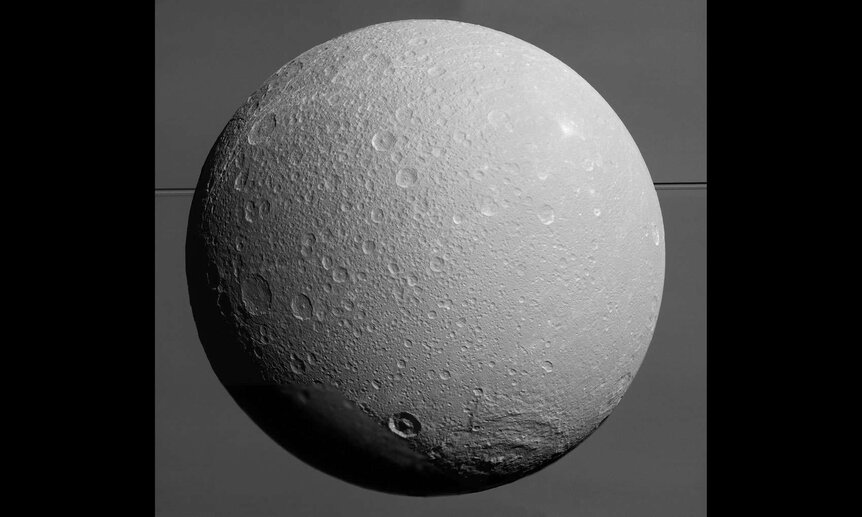Create a free profile to get unlimited access to exclusive videos, sweepstakes, and more!
Is Saturn’s moon Dione still cryovolcanically active?

Every now and again, I am strongly reminded that the Universe is really weird.
We’re used to the way things go on Earth. We have air, the wind blows, most of the surface is water. And when we think of volcanic eruptions, we think of molten rock spewing up from the planet’s extremely hot interior.
But far away from the Earth and Sun there are bodies that are too cold and small to have molten rock. Heck, they hardly have any rock. Yet they too can be volcanic… except in their case it’s liquid water erupting out, freezing onto the surface as ice. We call these cryovolcanoes, and we see evidence for them on asteroids just outside the orbit of Mars out to Pluto.
Saturn has a lot of icy moons, and we know Enceladus is active cryovolcanically; it has geysers of liquid water erupting from it right now. The source is a huge ocean of liquid water under its surface, created by internal friction as the tides from Saturn squeeze and stretch the tiny moon.
Another icy Saturn moon is Dione. Like Enceladus it’s thought to have a salty liquid water ocean under its thick shell of surface ice. And like all moons in the solar system, it’s tidally locked to Saturn, meaning it rotates once on its axis for every once it orbits around the planet. That means it always shows the same face to Saturn (like our Moon does to Earth), but more importantly, one hemisphere faces into its direction of travel (the leading hemisphere, like the front windshield of a car) and the other faces away (the trailing hemisphere).
Both sides are heavily cratered, but the trailing side is also covered in enormous cliffs and fractures. When Voyager 1 passed Saturn in 1980, it saw these features but couldn’t see them clearly. They look like tendrils or fuzz in the images, so they were dubbed wispy terrain. The Cassini spacecraft’s much higher resolution images revealed them to be cliffs.
New research using Cassini data of Dione shows that these cliffs are very young. Possibly very very young.
They focused on a region called Padua Chasmata, near Dione’s equator in the trailing hemisphere. The cracks in the icy surface are obvious, and can be seen to cut right across craters, indicating at least they’re younger than those impact features.
But the team of planetary scientists could do better than guess.
When water erupts out from below the surface, it freezes and becomes crystalline. However, that changes over time. Saturn has a powerful magnetic field, which traps and accelerates charged particles. The magnetic field rotates with Saturn in about 10 hours, but Dione takes 66 hours to orbit Saturn, slower than the magnetic field. That means the ions trapped in the field catch up to and slam into the trailing hemisphere of Dione (like a faster car rear-ending a slower one).
When those particles hit ice, they break apart the hydrogen and oxygen molecules. The hydrogen then very slowly diffuses through the ice, breaking apart the crystalline structure. Given enough time — many millions of years — the ice becomes completely amorphous: Still frozen, but no longer a crystal.
The rate at which that happens can be modeled, and that means the age of the ice can be determined. The older it is, the more amorphous it is.
Amorphous ice and crystalline ice reflect infrared light differently, and Cassini has a camera that could distinguish the two. Looking at the data from Padua Chasmata, the scientists found that at most the ice was a mere 2% amorphous. In other words, it’s still almost entirely crystalline, and therefore (geologically speaking at least) extremely young.
Given their models, a 5% amorphous ratio would mean the ice was 200 million years old. The fact that at most it was 2%, and in some places far less, indicates it may be much younger than that. They can’t necessarily rule out that some of that ice may be created even now. If true, that means Dione is cryovolcanically active today.
To be clear, they cannot state that positively. The data aren’t clear enough, and the ice may be tens of millions of years old. But even that is pretty cool; Cassini only made good observations of one spot on the moon, and the odds of just so happening to look at the very youngest spot are low. That means other spots might be younger. And even a few million years is considered recent in events like this. Remember, Enceladus is still actively shooting water into space via geysers, so the idea that Dione might yet be active isn’t so silly.
It’s easy to think of the outer solar system as frozen and static and dead. But the more we look, the more we see how mistaken that is.





























